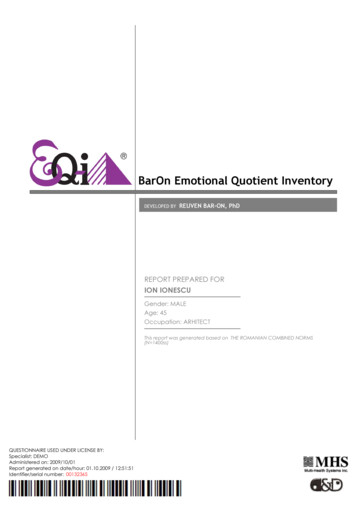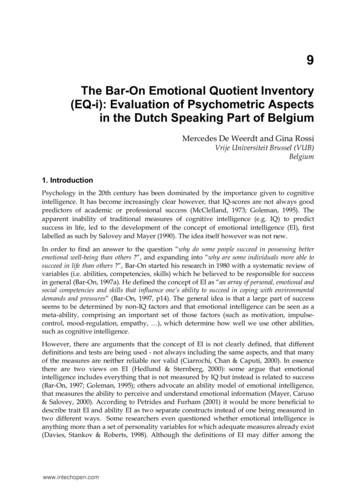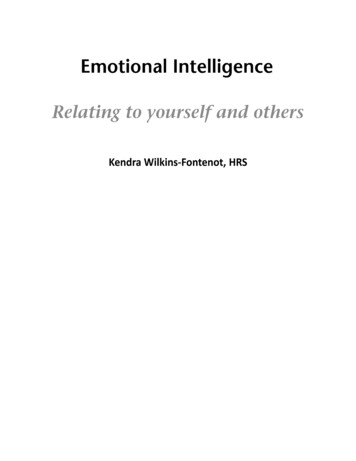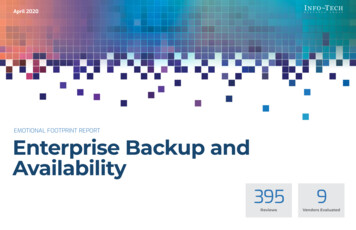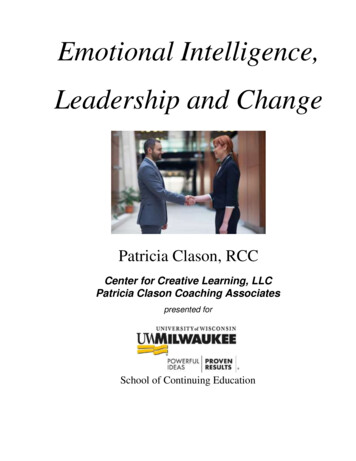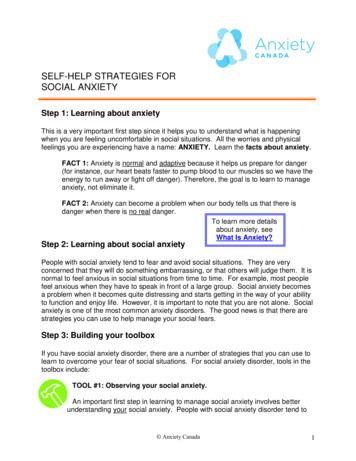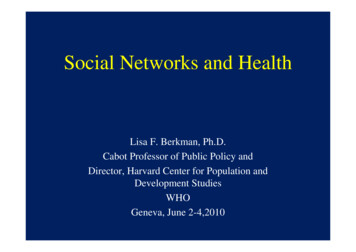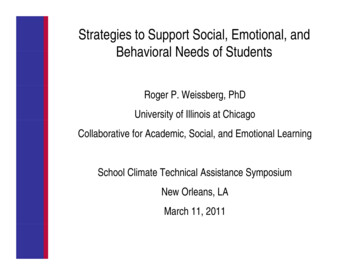
Transcription
Strategies to Support Social, Emotional, andBehavioral Needs of StudentsRoger P. Weissberg, PhDUniversity of Illinois at ChicagoCollaborative for Academic, Social, and Emotional LearningSchool Climate Technical Assistance SymposiumN Orleans,NewOlLAMarch 11, 2011
Reflection QuestionIf you could pick one quality or skillthat all young people would possessby the time they graduate from highschool, what would it be?Turn to a neighborand explain.
Primary Mental Health Project: A Program for the Early Detection andPrevention of SocialSocial, EmotionalEmotional, and Behavioral Problems1. Focus on primary-grade children2. Systematic screening3. Non-professional counselor assistants4 Changing role for school mental health professionals4.5. Evaluation and intervention from multiple perspectives
A Caring, Connected, Responsible,Contributing Problem Solver STOP, CALM DOWN, & THINK before youact SayS theth PROBLEM andd howh you FEELSTOP Set a POSITIVE GOAL THINK of lots of SOLUTIONSTHINKGO THINK ahead to the CONSEQUENCES GO ahead and TRY the BEST PLAN
Risky Youth Behaviors and Attitudes:PPrevalencelforf HighHi h SchoolS h l StudentsSt d tIssues: Physical fight 1 or more times (12 months):31% Carried a weaponp ((30 days):y )17% Bullied at school (past 6 months):28% 5 or more drinks in a couple of hours (30 days):24% Seriously considered attempting suicide:14% Sexual intercourse with 3 people:14% Chronically disengaged from school:40-60%
Social and Emotional Skills and Attitudes:Prevalence for 6th to 12th gradersAssets:How people you know well would rate you on: Thinking through the results off your choices,planning ahead29%% Caring about others’ feelingsfeelings, feeling sad whena friend is unhappy, being good at making andkeeping friends45% Respecting the values/beliefs of people of differentraces/cultures43% My school provides a caring, encouraging environment 29%
Essential QuestionsEach Community Must AnswerWhat do we want ourchildrenhild tto bbe, tto kknow,and to be able to dowhenh ththey graduate?d t ?How can the entire community be organized toensure thatth t allll studentst d t reachh theth statedt t d goals?l ?
SEL as a Coordinating Framework.to a better place for kids BuiltB ilt on studentt d t strengthstth Academic and life success Coordinated efforts Systemic integration
A Simplified Framework for EnhancingStudent Success in School and LifeTeach &M d lModelSpecific SESkills ImproveCli t &ClimateLearningEnvironmentSource: SEL and Academics: Research Brief, Collaborative forAcademic, Social and Emotional Learning, 2007. PositiveResults forChildren
What is Social and Emotional Learning?SEL is a process of acquiring knowledge and skillsrelated to five core competencies:Recognize one’s emotions,values, strengths, andlimitationsManage emotionsand behaviorsto achieveone’s ingd empathyh makingRelationshipskillsMake ethical,constructive choicesabout personal andsocial behaviorForm positivep , workrelationships,in teams, deal effectivelywith conflict
SEL Conceptual Framework for Academic, Social,anddEEmotionalti l l, Family,and CommunityCProgrammingSocial,Emotional, andA d iAcademicLearningHealthyGood SocialRelationshipsEngaged Citizens
What are the Latest Research Advances?
Meta-analysis: SEL Promotes Success in SchoolDurlak, Weissberg, Dymnicki, Taylor, & Schellinger (2011)Coordinated School,, Family,y, and Communityy ProgrammingggPositive SocialBehaviorSELSLearningEnvironmentSE SkillsInstructionSE SkillAcquisitionImprovedAttitudesFewer ConductProblemsLess EmotionalDistressAcademicSuccess
Meta-analysis: Core Questions1 D1.Does school-basedh l b d SEL programmingi positivelyiti l affectff tstudents?2. Are SEL programs conducted by existing school staffeffective?3. Do training practices and the quality of implementationaffect student outcomes?
Benefits of Social and Emotional LearningGood Science Links SEL to the Following Student Gains: Social-emotional skills Improved attitudes about self, others, and school Positive classroom behavior 11 percentile-point gain on standardized achievement testsAnd Reduced Risks for Failure Conduct problems Aggressive behavior Emotional distressSource: Durlak, J.A., Weissberg, R.P., Dymnicki, A.B., Taylor, R.D., & Schellinger, K. (in press). The Impact ofEnhancing Students’ Social and Emotional Learning: A Meta-Analysis of School-Based Universal Interventions. ChildDevelopment.
SEL Improves Academic Outcomes Attitudes Motivation, commitment Behaviors Participation,p, studyy habits Performance Grades,Grades subject masterySource: Zins, Weissberg, Wang, & Walberg (2004). Building AcademicSuccess on Social and Emotional Learning (SEL): What Does theResearch Say?
Longitudinal Findings from the Seattle SocialDevelopment Project at Age 21 (Hawkins et al.)al ) More high school graduates More attending college Moreo e eemployedp oyed Better emotional and mental health FewerFwithith a criminali i l recordd Less drug selling Less co-morbid diagnosis of substance abuse andmental disorderCost-benefit: 3.14/student for 1.00 invested
Are SEL programs conducted byexisting school staffff l skillAttitudesPositive social behaviorConduct problemsEmotional distressAcademic performanceResearcher
Does the quality of implementationaffect student onalSocialemotional skillsAttitudesPositive social behaviorConduct problemsEmotional distressAcademic performance
How Do We Develop Students’Social and Emotional Skills? Sequenced, Active, Focused, Explicit (SAFE)programming Adults and students model SEL skills and discussrelevant situations (teachable moments) Developmentally/culturallypyy competentpinstruction andcommunity-building activities Students have opportunities to contribute to theirclass, school, and community
Autonomy, Belonging, CompetenceLessTeacher lectureTeacher interventionInflexible disciplineCompetitionLiteral comprehensionpIndependent seatworkParent-school isolationBenevolente e o e t ddictatorshipctato s pRewardsMoreStudent inputStudent pproblem solvinggNatural consequencesCaring communityHigherg level discussionsCooperative learningSense of partnershipStudent centered democracyySelf-assessment
Effects of SEL Participation on Teachers:S lfSelf-reportedt d SurveySResponsesR% 6th-grade teachers reporting improvement% 9th-grade teachers reporting improvement969610079Problem-solvingComm. w/ students8883Dealing w/ stress
Principals’ Responses:Personal Transformation The training I received from SEL has brought a focus and areflection to my leadership skills. It has taught me to recognizethe relationship between my feelings and my job performanceas a school leader. I am definitely more in touch with my values as an educator asa result of working with SEL at my school. I realize that it isnot just about academics; rather we are responsible fornurturing the entire child and SEL assists us in doing that.
Implications for Practice & PolicySEL works Multiple positive outcomes including academicachievement Across grade levels and contextsSEL is doable Good results from programs run by existing schoolstaffSEL needs support Implementation matters Supported by federal and state policies, leadership, andprofessional development
Three IL Social & Emotional Learning GoalsSelfOtherDecision‐makingSEL Goal 31SEL Goal 32SEL Goal 33Develop self‐awareness andself managementself‐managementskills to achieveschool and lifesuccess.Use social‐awareness andinterpersonalskills toestablish on‐makingskills andresponsiblebehaviors inpersonal, school,and communitycontexts.
Safe and Sound: An Educator’s Guideto EvidenceEvidence-basedbased SEL Programs
CASEL 200827
Sustainable Schoolwide SEL:I lImplementationt ti GuideG id andd ToolkitT lkit Readiness phase Planning phase Implementation phase Sustainability factorsSustainable SchoolwideSocial and EmotionalLearning (SEL)Collaborative for Academic,Social, and Emotional LearningElizabeth DevaneyMary Utne O’BrienHank ResnikSusan KeisterRoger P. WeissbergIMPLEMENTATION GUIDE AND TOOLKIT
The CASEL Rubric: Implementation StepsReadiness Stage Principalp is committed to implementingpg SEL in the school. Principal engages key stakeholders and creates SEL steeringcommittee.Planning Stage Develop a shared vision of SEL. Conduct a schoolwide needs and resource assessment. Develop an action plan. Select an evidence-based program.Implementation Stage Conduct initial professional development activities. Launch SEL instruction in classrooms. Expand classroom-based SEL programming and integrate SELschoolwide. Revisit implementation activities and adjust for continuousimprovement.
A Coordinated Districtwide Model forAcademic SocialAcademic,Social, and Emotional LearningPlanned, systematicclassroom-based SELinstruction and a supportiveschool climateCoordinated mental healthand health services thatreinforce SEL instructionSchool-Family-Communitypartnerships to enhance social,emotional,ti l andd academicd icompetenceAfter-school and communityactivities that arecoordinated with SEL efforts
Summary SEL is the process whereby children and adults developessential social and emotional competencies.competencies SEL improves school-related attitudes, behaviors, andacademics and provides the foundation for life success.success Well-designed, well-implemented SEL programmingproduces the best outcomes.outcomes Sustainable, effective schoolwide SEL requires 6 Ps:Policy Principals (or suPerintendents!),Policy,suPerintendents!) Planning,PlanningProfessional development, Program evaluation, andPartnerships.
Why Implement SEL in Schools? Relationships provide a foundation for learning Emotions affect how and what we learn Relevant skills can be taught Positive effects on academic performance, health, relationships,and citizenshipp Demanded by employers Essential for lifelong success A coordinating framework to overcome fragmentation ofprevention and youth-developmentyouth development programs
SEL Prepares Studentsfor College and CareersSelf-Discipline, Initiative, and Self-AdvocacyCommunicationTeam Work and CollaborationLeadershipCritical Thinking and Problem-SolvingEthics and Social ResponsibilityGlobal Awareness
A Vision for SEL: Classroom, School, District,State, Nation, WorldEducators, students, families, and communityymembers work together to support the healthydevelopment of all students.All students are engaged and active learners whoare self-aware,self aware caringcaring, respectful,respectful connected toothers, responsible decision makers, and academicachievers.Students are contributing in positive ways to theirh l andd community.itschool
SWPBS (aka PBIS/RtI) isFramework for enhancingadoptiond ti & iimplementationlt ti offContinuum of evidencebased interventions toachieveAcademically & behaviorallyimportant outcomes forAll students
iorAnalysisPBIS1997Positive BehavioralInterventions 90sResponsetoIntervention37
PRACCTICE“MakingMaking aturn”EffectiveIMPLEMENTATIONEffectiveMaximumSt d tStudentBenefitsNotEffectiveFixsen & Blase, 2009Not Effective
IntegratedElElementstSupporting Social Competence &Academic ortingStaff BehaviorPRACTICESSupportingStudent Behavior
IMPLEMENTATIONTEAMFACILITATED W/ FIDELITYCONTINUUM ISE &FLUENCYCONTINUOUSPROGRESSMONITORING
CONTINUUM OFSCHOOL-WIDEINSTRUCTIONAL &POSITIVE BEHAVIORSUPPORTFEW 5% e Systems forAll Students,,Staff, & SettingsALL 80% of StudentsTertiary Prevention:SpecializedIndividualizedSystems for Studentswith High-Risk BehaviorSecondary Prevention:Specialized GroupSystems for Studentswith At-Risk Behavior
IntensiveTargetedUniversalFewFSomeAllDec 7, 2007Continuum ofSupportSt forfALL
MathIntensiveScienceContinuum ofSSupportffor ALL“Theora”TargetedSpanishReadingSoc skillsUniversalSoc StudiesBasketballLabel behavior notpeopleDec 7, 2007
ESTABLISHING CONTINUUM of SWPBS - EXAMPLE 5% 15%TERTIARYTERTIARY PREVENTIONPREVENTION Function-based support Wraparound Person-centered planning SECONDARYSECONDARY PREVENTIONPREVENTION CheckCh k iin/out/ t Targeted social skills instruction Peer-based supports Social skills club 80% of StudentsPRIMARYPRIMARY PREVENTIONPREVENTION Teach SW expectations Proactive SW discipline Positive reinforcement Effective instruction Parent engagement
SWPBSP tiPracticesClClassroomNon-classroomStudent &F ilFamilyFamily
SCHOOL‐WIDECLASSROOM1.1. Leadership team1.All school‐wide2 B h i purpose statement2.Behaviort tt3.Set of positive expectations & behaviors4.Procedures for teaching SW & classroom‐wideexpected behavior5.Continuum of procedures for encouragingexpected tinuum of procedures for discouraging ruleviolationsINDIVIDUAL STUDENT2.Function‐based behavior support planning3.Team‐ & data‐based decision making4.Comprehensive person‐centered planning &wraparound processes5.Targetedgsocial skills & self‐managementginstruction6. Individualized instructional & curricularaccommodations3.Positively stated expectations posted, taught,reviewed, prompted, & supervised.4M i4.Maximumengagementt throughthh highhi h ratest offopportunities to respond, delivery of evidence‐based instructional curriculum & practices5.Continuum of strategies to acknowledge displaysof appropriate behavior.6.Continuum of strategies for responding toinappropriate behavior.7.Procedures for on‐going data‐based monitoring &evaluation1.Behavioral competence at school & district levels2.Maximum structure & predictability in routines &environmentNONCLASSROOM1.Positive expectations & routinestaught & encouragedFAMILY ENGAGEMENT1.Continuum of positive behavior support for allfamilies2.Frequent, regular positive contacts,2.Active supervision by all staff (Scan, communications, & acknowledgementsmove, interact)3.Formal & active participation & involvement as3.Precorrections & remindersequal partner4.Positive reinforcement4.Access to system of integrated school &community resources
School-wide1. Leadership team2. Behavior purpose statement3. Set of positive expectations & behaviors4 Procedures for teaching SW & classroom4.classroom-widewideexpected behavior5. Continuum of procedures for encouraging expectedbehavior6. Continuum of pprocedures for discouragingg g ruleviolationsg g data-based monitoringg&7. Procedures for on-goingevaluation
riaLibrary/Computer LabHave a plan.Eat all emblyBusSit in onespot.Watch foryour stop.Be on task.Give yourbest effort.Beprepared.Walk.RespectOthersBe kind.Hands/feetto selfself.Help/sharewithothers.Use normalvoicevolume.Walk toright.Play safe.Includeothers.Shareequipment.Practicegood propriateapplause.Use a quietvoicevoice.Stay in yourseat.RespectPropertyRecycle.Clean upafter self.Pick y.Put litter ingarbage can.Replacetrays &utensils.Clean upeating area.Push inchairs.Treatbookscarefully.Pick up.Treat chairsappropriately.Wipe tionsSETTINGTeachingThi didirectlytl iincontext
SWPBSImplementationBlueprintwww.pbis.org
edAction PlanEvaluationImplementation
Evaluation CriteriaEffective Achieve desired outcome?Efficient Doable by real implementer?Relevant Contextual & cultural?Durable Lasting?Scalable Transportable?Logical Conceptually Sound?
Sample Teaming tendanceIncrease % ofstudents attendingdailyyAll studentsEric, Ellen,MarleeGoal #2CharacterEducationImprovecharacterImprove characterAll studentsMarlee, J.S.,EllenGoal #3SafetyCommitteeImprove safetyPredictable responseto threat/crisisDangerousstudentsHas not metGoal #3School SpiritCommitteeEnhance schoolspiritImprove moraleAll studentsHas not metDisciplineCommitteeImprove behaviorDecrease epeatoffendersEllen, Eric,EllenEricMarlee, OtisDARECommitteePrevent drug useHigh/at-riskdrug usersDonEBS Work GroupImplement 3-tiermodelAll studentsEric, Ellen,Marlee OtisMarlee,Otis,EmmaDecrease officereferrals increasereferrals,attendance, enhanceacademicengagement, improvegradesGoal #3Goal #2G l #3Goal
Mar 23, 2011 · Summary SEL is the process whereby children and adults develop essential social and emotional competencies . SEL improves school-related attitudes, behaviors, and academics and provides the foundation for life success. Well-designed, well

